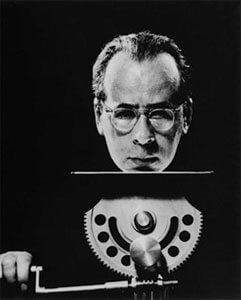Philippe Halsman was born in Riga, Latvia and began his photographic career in Paris. In 1934 he opened a portrait studio in Montparnasse, where he photographed many well-known artists and writers — including
André Gide,
Marc Chagall,
Le Corbusier, and
André Malraux, using an innovative twin-lens reflex camera that he designed himself.
Part of the great exodus of artists and intellectuals who fled the Nazis, Halsman arrived in the United States with his young family in 1940, having obtained an emergency visa through the intervention of
Albert Einstein.
Halsman’s prolific career in America over the next 30 years included reportage and covers for every major American magazine. These assignments brought him face-to-face with many of the century’s leading statesmen, scientists, artists and entertainers. His incisive portraits appeared on 101 covers for
Life magazine, a record no other photographer could match.
Part of Halsman’s success was his joie de vivre and his imagination — combined with his technological prowess. In 1945 he was elected the first president of the
American Society of Magazine Photographers (ASMP), where he led the fight to protect photographers’ creative and professional rights. In 1958 Halsman’s colleagues named him one of the World’s Ten Greatest Photographers. From 1971 to 1976 he taught a seminar at
The New School entitled
Psychological Portraiture.
Halsman began a thirty-seven-year collaboration with
Salvador Dali in 1941 which resulted in a stream of unusual
photographs of ideas, including
Dali Atomicus and the
Dali’s Mustache series. In the early 1950s, Halsman began to ask his subjects to jump for his camera at the conclusion of each sitting. These uniquely witty and energetic images have become an important part of his photographic legacy.
Writing in 1972, Halsman spoke of his fascination with the human face.
“Every face I see seems to hide – and sometimes fleetingly to reveal – the mystery of another human being. Capturing this revelation became the goal and passion of my life.”Source: Magnum Photos
Over the course of his career, Halsman enjoyed comparing his work to that of a good psychologist who regards his subjects with special insight. With his courtly manners and European accent, Halsman also fit the popular stereotype at a time when Americans regarded psychology with fascinated skepticism. In fact, Halsman was proud of his ability to reveal the character of his sitters. As he explained,
"It can't be done by pushing the person into position or arranging his head at a certain angle. It must be accomplished by provoking the victim, amusing him with jokes, lulling him with silence, or asking impertinent questions which his best friend would be afraid to voice."
In the spring of 1952, Halsman put his signature technique to work when
Life sent him to Hollywood to photograph
Marilyn Monroe. Halsman asked Monroe to stand in a corner, and placed his camera directly in front of her. Later, he recalled that she looked
"as if she had been pushed into the corner cornered with no way to escape." Then Halsman, his assistant, and Life's reporter staged a
"fiery" competition for Monroe's attention.
"Surrounded by three admiring men she smiled, flirted, giggled and wriggled with delight. During the hour I kept her cornered she enjoyed herself royally, and I . . . took between 40 and 50 pictures."
In this widely familiar portrait, Monroe wears a white evening gown and stands with her back against two walls, one dark, the other light, her eyes half-closed and her dark, lipsticked mouth partly open. Yet Halsman deftly avoided any explicit representation of the true subject of the picture. Using the euphemistic language of the time, Halsman's assistant admired the photographer's ability to make
"suggestive" pictures of beautiful women which still showed
"good taste," emphasizing
"expression" rather than
"physical assets." And then the assistant added,
"Halsman is very adept at provoking the expression he wants."Source: National Portrait Gallery
